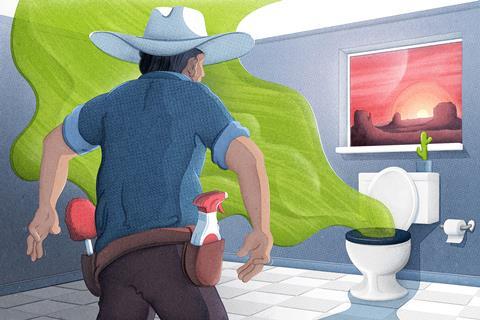Scientists are helping to save water – and time spent cleaning the loo – by preventing excrement sticking

Scientists have to solve some sticky problems – and perhaps none stickier than this one. They’ve worked out how to stop poo sticking to the toilet bowl and their discovery dramatically reduces the amount of water needed to flush the toilet.
We all flush the toilet about eight times a day and that uses a lot of water – about 28,000 litres per UK home, per year. UK-wide, our toilet-flushing alone equates to the total water consumption of 108 million people in Africa.
At home, your toilet might have a special flush mechanism that allows you to flush with less water when it’s ‘just a wee’. But most of us, even with modern toilets, use at least five litres of water every time. If we used a lot less, it wouldn’t get the toilet clean.
Materials scientists and engineers at Pennsylvania State University in the US and Cranfield University in the UK looked at this problem in a new way. What if, they thought, we made the inside of the toilet so slippy that the poo would just slide right off? Then you wouldn’t have to use as much water to clean it.
This bright idea was the starting point for a nose-wrinkling series of experiments. But first, the team of scientists and engineers had to find a way to make the inside of a toilet bowl really slippy. They came up with this two-part, spray-coating process: first, spray a polymer that forms an ultra-thin, ultra-smooth layer onto the toilet bowl; then, spray a lubricant on top. Despite being ultra-smooth, the molecular structure of the bottom layer acts as a kind of chemical grip for the top lubricant layer, keeping it stable. The whole process takes less than five minutes.
This bright idea was the starting point for a nose-wrinkling series of experiments (go.nature.com/35Z3F7A). But first, the team of scientists and engineers had to find a way to make the inside of a toilet bowl really slippy. They came up with this two-part, spray-coating process: first, spray a polymer that forms an ultra-thin, ultra-smooth layer onto the toilet bowl; then, spray a lubricant on top. Despite being ultra-smooth, the molecular structure of the bottom layer acts as a kind of chemical grip for the top lubricant layer, keeping it stable. The whole process takes less than five minutes.
To test their anti-stick coating, they tried dropping artificial poo (made from yeast, peanut oil, miso and a handful of common lab chemicals) on to glass and, as they hoped, the poo slipped straight off. In fact, it took 90% less water to leave the glass clean with their anti-stick coating compared to bare glass. They had similar success using real human poo when they compared their coated glass to ceramics like those in toilets and even Teflon – a well-known anti-stick coating for frying pans.
It sounds like the perfect solution to our toilet water woes. One consideration though with anything we put in the toilet is whether it gets to into the sewer system, and if so, what happens then? When the scientists tested the durability of their coating, they estimated it would need to be replenished after about 50 wees, or 10–15 poos. In theory, for a family house with two toilets, the coating could start to break down within a week. Before this coating could be used on all toilets, we need to find out if it’s harmful to wildlife or people. And that might be what determines if this anti-stick solution sticks around.
More resources
Link curriculum learning to careers and read about consumer products technician, Robert who helps develop desirable properties for for products such as cosmetics and chewing gum.
Hayley Bennett














No comments yet